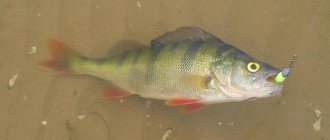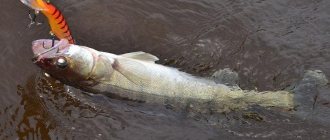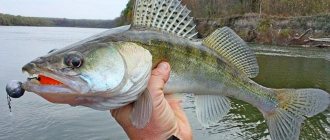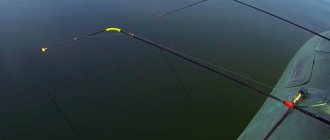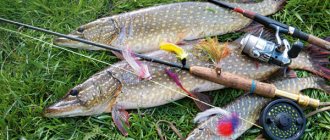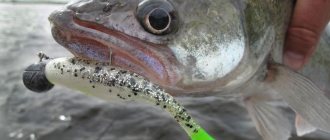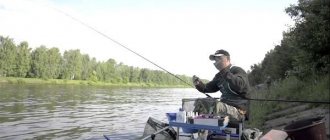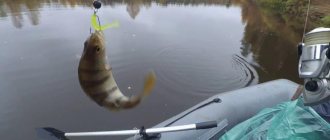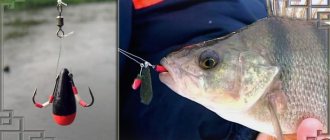Fishing for a man is not only getting a catch, but a pleasant and exciting pastime, so catching pike perch at night with a jig is one of the types of fishing that attracts the most avid fishermen. This type of fishing involves an interesting activity, which has its own characteristics and the presence of special equipment. Therefore, to successfully hunt pike perch at night, you need to prepare all the necessary gear. Fishing with a jig makes it possible to catch pike perch at great depths, as well as from a great distance. In addition, this method of fishing makes it possible to carry it out not only from a boat, but also from the coastal zone.
What if pike perch bites on a jig at night?
From September on the rivers you can catch pike perch very well at dusk and at night. This process is unfussy and in part unnoticeable. Young, inexperienced fishermen, having spent the whole day near the water, scouring the entire water area far and wide, and not catching a single “fanged” one, go home. After about an hour, experienced pike-perch fishermen arrive at the same place and perfectly catch the nocturnal predator with a jig.
My experience suggests that river pike perch is good at jigging at night all summer, and from September its bite becomes even more active, and fish are caught much larger than summer ones! Meanwhile, in August, when fishing at night, he prefers wobblers. For night jig fishing for pike perch, you need to be well prepared technically and have suitable gear. The more sensitive the spinning rod is in your hands, the better. The fishing line should, of course, only be braided!
To practice night fishing, you can test yourself by blind fishing during the day. Having closed your eyes, you need to focus on the sensations; the tackle transfers all events to your hand - palms and fingers. If you cast the bait without any problems and feel the bottom well when retrieving in steps, then you will succeed in the dark. It must be said that good 'night' jig tackle is not cheap and not everyone can afford it. Therefore, many local fishermen use inexpensive spinning rods with a monofilament with a diameter of at least 0.4 mm for night fishing. And, I must admit, they catch pike perch extremely well. The secret to success here is complete control over the wiring. The fact is that such fishermen perform both stepwise wiring and dragging by reading information directly from the fishing line with their fingers. But at night this is not required, the bite is transmitted so clearly that it feels as if a current was passed through the spinning rod through your hands! The pike perch takes parts at night more sharply and greedily than during the day, sits down and begins to resist almost immediately.
Spinning rod for jig fishing
For coastal fishing for pike perch with jig, a rod with a length of 3 to 3.5 m is used.
Long spinning rods have their advantages, for example, by raising the rod high, it is possible to avoid many snags when pulling the jig bait over the edge, and it is easier to work near the coastal grass.
As for the rod action, some spinning anglers prefer fast and hard rods, while others prefer rods with a semi-parabolic action.
More “sticky” spinning rods have such advantages as a minimum number of trips when fishing, longer casting of the bait, and the versatility of the rod, which allows you to replace a heavy jig bait with a wobbler or spinner.
The rod test is directly dependent on the fishing conditions. If fishing is carried out on a river with a strong current and considerable depth, then the rod should have a test weight of 20-60 g. When fishing in a shallow reservoir, a rod with a test weight of 5-40 g is sufficient.
Spinning rod Daiwa Megaforce 10-30 g - a budget model that has proven itself among experienced fishermen
An important element of a good jig tackle will be a reel. Sometimes it’s better to save on a fishing rod, but buy a good, durable reel with a power reserve. The most suitable size would be 3000. It will cope with heavy baits without loss of sensitivity.
When using such equipment elements as winding rings, swivels, connecting links, metal leashes, careful selection and competent use are required.
How and what to catch pike perch in the fall at night?
Of course, a good baitcasting reel complete with a high-quality “stick” is far superior to any fishing kit of most local fishermen both in terms of casting characteristics and sensitivity. But don’t be upset if you have an ordinary “meat grinder” on an average “Korean”! A little sharper hook - and that’s it! And casting range and casting accuracy are much less critical at night than during the day!
Most often at night I use medium and fairly large twisters and vibrating tails. Naturally, if the bait is too saily and does not reach the pike perch’s place, its size will have to be reduced. Although at night, ultra-long casts are usually not required. The large size of the bait is needed to make it easier for the pike perch to notice it, and also to quickly provoke the predator to bite. But it often happens that the largest pike perch covets the most ordinary small twister.
Large vibrating tails and twisters, equipped with triple hooks, are used in areas that are clear of snags. Their use reduces the number of empty bites to a minimum. The color of silicone baits at night is very important. For several seasons in a row, bright lemon-green baits were considered the most universal for me, then they gave way to a combination of two colors - bright scarlet and lemon yellow. Then I switched to glowing rubber and have been fishing with it ever since. I would like to draw your attention to the fact that when fishing with glowing rubber, you don’t need to try to “charge” it often, pike perch don’t like that! A slight residual glow, a dull shine, is much more productive. “Charging” the flashlight should occur no more than once every 20-30 minutes. At least for me, there were more bites. Apparently, the pike perch liked the barely visible glow!
Offset hooks allow you to quickly turn a silicone bait into a formidable “no-hook”. It's time to stop at equipping the “rubber” with hooks. If the place where you catch pike perch has a clean bottom, then there is simply no alternative to a high-quality sharp tee! In this case, the number of empty bites, especially directly from the bottom, is reduced to zero. If there is a possibility of hooks, and this is generally the case in most pike-perch places, then there is a need to use large offset hooks. By large we mean hooks No. 4 and No. 5, since on smaller hooks it is simply impossible to correctly position a large silicone bait. It is better to prefer those offset hooks with the tip directed towards the ring. Experience shows that they hook pike perch better, since their sting is only slightly pressed on top of the silicone. Equipping the bait with an offset hook makes it possible to effectively fish not only in “strong” places, but also where the bottom is clean. For fishing in areas with a clean bottom, you can safely remove the hook from the body of the bait, and thereby raise the hook tip. With such a flexible approach, you can effectively fish using the same bait in both clear and remote areas, which is undoubtedly very convenient at night.
In addition to silicone baits, it is very effective to use fish made from foam rubber or window seals when fishing for pike perch at night. The most effective retrieve for such a fish bait turned out to be simply dragging it slowly along the bottom.
Choosing jig baits
Pike perch is a picky fish and has different effects on certain colors. Everyone knows that this fish prefers bright orange, acidic lemon, green and white colors. So attention should first fall on them.
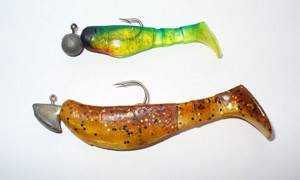
All baits are on average small in size, but there are also larger sizes, for example, for catching pike or catfish. For pike perch you should choose baits of sizes 10-12 cm.
You should understand in more detail the types of jig baits, of which there are three in the world of fishing:
- silicone twisters and vibrotails;
- foam fish;
- polyurethane foam fish.
Vibrating tails and twisters are made from silicone and are similar to fish with long and dangling tails. They come in a variety of colors and shapes, and sometimes have glitter options that attract fish. Experienced spinning anglers prefer the following manufacturers: Crazy Fish, Reins, Assassin, Mann's, Lucky John.
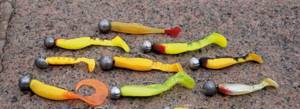
Foam rubber fish can be made at home in just a few minutes using scissors and a piece of foam rubber. Instead of foam rubber, you can use multi-colored sponges for washing dishes, from which you can then make something that can drive a pike perch crazy and make it go to your hook. You can experiment with shapes and sizes.
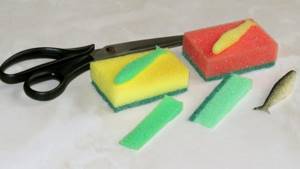
Polyurethane foam is also an excellent bait for catching walleye. From it, like from foam rubber, a fish of any size is cut out, and then melted over a fire or from the fire of a lighter. A simple and uncomplicated way to make your own bait, using your imagination and creativity.
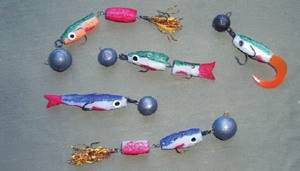
Where to catch pike perch in autumn
Like most other predatory fish, pike perch is attached to bottom irregularities. Steep edges and slopes are its favorite places to stop. The same is true for coastal waters. I found myself in a situation where the pike perch concentrated on a flat “field” - sandy shallow water with a depth of 1-2 m, only 10-15 m from the shore. Such places usually do not attract attention and are ignored by almost all anglers accustomed to deep day fishing. But it is precisely the flat sandy “beaches” at the border of the stream and the return, where small fish so often live in huge quantities, that are worth paying close attention to! The most favorite coastal places for pike perch are rocky, sandy with snags and washed-out clayey shores, ending with steep steps and ledges into the depths, which we calmly leave for late morning and afternoon.
It’s easier to go the other way - spy on the local fishermen. To do this, you need to wait until dusk and watch where the pike-perch cars are driving up. True, not everyone knows about night fishing for pike perch... But so much the better for you! When the river is known, and you have already caught pike perch in the morning and afternoon, it will be much easier to find its sites. But it may also turn out that out of 3-4 “points” only one will work at night. Before dark, each place must be prepared and trampled: measure the depth near the shore, since it is better to fish by wading, remove excess debris from under the foot and from the swing zone when casting, because in the dark a lot of baits come off on the shore!
As a rule, in the dark, the pike perch begins to peck first on the edge and only later rises to a flat “field” that is located nearby, higher up. Therefore, it is not worth skipping the edge at all; after passing it, we will probe all the small holes on the rise; we must definitely probe the entire shallows right up to the shore. On an autumn night, pike perch rarely fight aggressively; sometimes their hunt in the shallows is completely quiet! Meanwhile, fish weigh 3-5 kg. very densely inhabit small, coastal areas.
I sometimes had to catch pike perch just a few meters from the shore. The pike perch went out for prey to a depth of 30-50 cm. You didn’t even have to cast the bait, but simply put the spinning rod above the water and slowly move along the shore, rhythmically playing with a twister near the bottom. It is not uncommon to bite on a bait involuntarily lowered into the water when you are identifying prey on a kukan. You have to do the hook while holding the spinning rod under your arm! The most interesting thing is that if from the same place you throw a jig head with the same twister at full reach, you can find a fairly distinct and deep channel ditch at the bottom. Which rests on a sandbank, the channel bends, going to the side. Usually, pike perch loves such turns of the channel from the shore; it is located on its deep edges during the day, but at night it certainly goes to the shallows along the way. In such places, the number of bites under the shore can be up to 10-12 per hour, i.e. sometimes significantly more than during the previous daylight hours, and the fish were very good, on average 1–1.5 kg of pike perch, but there were specimens weighing 3.5-4 kg.
Night fishing
At the end of spring, the time comes for night fishing for pike perch. According to most masters of night pike perch fishing, the best time is the period from the end of May to the whole of June.
Before such fishing, you need to thoroughly prepare, choose a suitable place for fishing, arm yourself with a flashlight, select jig baits and weights, and practice during the day in casting bait and retrieving with your eyes closed.
When using a baitcasting reel, it is better to control the wiring with the fingers of the hand that holds the spinning rod.
Sufficiently large twisters are suitable for night fishing:
- Mann's 5-7.5 cm;
- Relax 10 cm;
- YUM 7 cm.
You can buy silicone soft baits from the best manufacturers, and then make a mold and cast them yourself
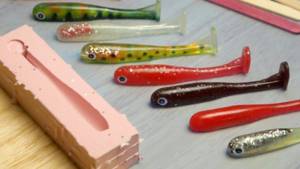
The vibrations of a large bait attract pike perch, and there are more bites.
For night fishing, equipping the spinning rod with braid becomes a prerequisite, but a metal leash is not needed.
The retrieve should be smoother than during daytime fishing. The pause duration reaches 5 seconds. It is preferable to use the American style of retrieving, which involves working with a rod rather than a reel.
In any case, wiring is slow at night.
Catching pike perch with a spinning rod - a general guide to the baits and equipment used.
Catching perch with a spinning rod - choosing a fishing spot, a story about spinning tackle and rigs.
Fishing for pike with a spinning rod - what baits to use, and is jig suitable? Read the review.
Weather
We don't choose the weather! To learn how to catch pike perch at night, you need not to be afraid of any weather, and be sure to go fishing! It turned out that the weather is not so important, since it happened to catch pike perch offshore in a raincoat or Gore-Tex in the rain, and in winter clothes when it was freezing, and in a T-shirt. The main natural factor that accompanied all successful “shore” fishing trips was the right wind! It was he who turned out to be the main ally, and the stronger he is, the better, of course, within reasonable limits. There is no need to hide from it, trying to find protected coves. Rather, on the contrary, you need to look for places open to the wind, with incoming waves breaking on the shore. Wind and large waves will certainly interfere with fishing, but this is exactly the case when it is better to neglect comfort. In principle, it is not so much the wind itself that is needed, but rather the waves. Imagine this picture: a river 200 m wide, the wind blowing against the current raises large waves with whitecaps. At the bend of the river, waves lash fairly against the washed-out, clayey shore. A strip of muddy water forms along the shore, with bubbles of foam and all kinds of plant debris washed out of the shore and driven by the current. And if the current is twisting in this place near the shore, then this is simply an ideal place for night fishing! The pike perch will not come there to look for fish that are gaping and busy searching for food! And small white fish really love the surf shore. Usually all bites occur at the border of muddy and clear water. The bites, as a rule, are very angry, and the pike perch itself behaves as if it had taken a sip of an energy drink. Maybe it’s the enrichment of water with oxygen that has this effect on him, or maybe it’s something else unknown to us, but the changes are obvious. Sometimes the effect of the wind is very obvious. The weather has been great for a week, calm, the fishing results are stable, but not particularly impressive. Then the weather deteriorates, the wind disperses the waves and almost all anglers, and the night pike perch becomes incredibly active. Then the weather gets better again, and the bite subsides along the shore. All this can even happen within one night and even within just 2-3 hours!
A rapidly falling water level can scare the pike perch and drive it away from the shore. In this he is not original; all other fish do the same. When the water rises, the fish approaches the shore edge more boldly.
Jigging for pike perch at night
When fishing for pike perch at night, the classic step-retrieving method and dragging the bait along the bottom are most often used. If we talk about stepped retrieving, then its shortened versions work best, in which the bait is always at the bottom and makes short, no more than 1.5 m, jumps. This step requires no more than 2-2.5 full turns of the spinning reel handle. When using stepped casting, the cast is made perpendicular to the current or slightly higher, and then the casting is performed using intermittent rotation of the reel. If the current at the fishing spot is fast, then after several full steps to drift, the bait will begin to hang in the water column. In this case, the bottom is naturally lost! What should I do? The easiest way to deal with this scourge is to switch to wiring with the recoil of the fishing line or wiring using pulls with a spinning rod up and down, practically without reeling in the fishing line. In this case, the bottom is again felt even when using baits with relatively light heads. Dragging is done in such a way that the bait touches the bottom almost all the time. If the bait hangs, then you need to smoothly release a little fishing line. In strong currents, the wiring turns out to be two-phase. First, drift in an arc while slowly reeling in the line, and then the release of the line and subsequent rapid retraction of the line when the bait hits the coastal zone.
Drawing is best done using either a multiplier reel or a regular inertia reel, since the sensitivity of the gear is maximum, and the wiring is very well controlled by the trembling of the fishing line between the fingers. If you are fishing with a jig using a “meat grinder”, then it is better to perform dragging by casting against the current, and after the bait touches the bottom, slowly reel in the line. At the same time, do not lose contact with the bait and try to constantly feel the bottom. Which of these two fishing lines works better when catching night pike perch is difficult to say. Sometimes a shortened step is very effective, and sometimes dragging is beyond competition. For wiring by dragging, you can very effectively use the “monofilament paternoster” rig, with an additional twister on a 10-12 cm leash, fixed 40-70 cm (depending on the depth) above the main bait. At the moment of mass stranding of pike perch and its hunting, up to 90% of bites occur precisely on this unloaded, upper twister. Unfortunately, in complete darkness she often gets confused, which somewhat limits her capabilities.
Installing jig wiring
But here the angler must have certain skills, skillfully cope with wiring, feel the bottom and read the topography of the reservoir. Attentiveness is paramount here. The sensitivity of the rod will also be an important factor; the higher it is, the greater your chances of catching a trophy and generally noticing a bite.
When fishing on the shore, what is most important is the strength of the current in the reservoir, since a bite can simply be confused with the drift of the bait due to the strength of the current.
If fishing is done from a boat, then you need to hook with every movement, as this may be a bite.
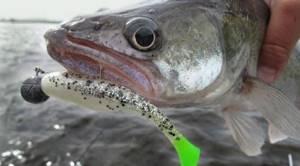
Light and illumination
Catching pike perch in complete darkness has its own nuances. On the one hand, it is better not to use a backlight, as this scares the fish and blinds you for 2-3 minutes. During this period of time after turning off the light, absolutely nothing is visible and if you are careless, you can trip and fall into the water. On the other hand, without a light you won't be able to change the bait or inspect it. Nowadays, the ideal solution has emerged - small LED headlamps. They provide dim, diffused light and are very economical. Headlamps are more convenient, since both hands remain free. In general, the influence of illumination on the pike perch bite is very noticeable. This is noticeable by the fact that on moonlit nights the bite is usually much worse than on dark, stormy nights. Therefore, do not use bright light sources directly in the fishing area unless absolutely necessary. A headlamp should only be used when necessary, such as when you need to tie a bait or unhook a hook deep in the mouth.
Jig heads and front loaded lures
Jig fishing involves fishing with front-loaded baits.
Lures are loaded:
- A Cheburashka sinker to which an offset hook for silicone bait or any other equipment is attached.
- Jig head (a lead sinker into which a hook is already inserted; all you have to do is attach a silicone bait to it).
The advantage of the Cheburashka in a jig rig is that you can insert not a single hook, but, for example, a tee - for better contact with the fish. But the simplest solution is still a jig head.
Time to catch pike perch at night
As practice shows, in early September, pike perch follows the summer feeding regime and bites best from 10 pm to 1 am. And by October, with further cooling and the transition to the winter mode of life, it begins to get better at dusk, from 18 to 22 hours. It must be said that after a fairly clearly defined night break of 2-3 hours - in September and 5-6 hours – by October, the pike perch has a pre-dawn burst of bite, in the morning twilight. At this time, the pike perch bites less actively, sometimes only 0.5-1 hour, bites occur at a greater distance from the shore, but the size of the pike perch is often larger than in the first half of the night.
Pike perch is quite predictable, although sometimes completely inexplicable bursts of bite occur on “bright” moonlit nights, in calm weather, when pike perch chases small things and plops at the very feet all night until the morning, calming down and giving way to perch, only at dawn, sensing the first rays of the rising sun! Always catch! Only frequent trips can bring us priceless “golden” grains of experience!
Kosalapin Ivan
